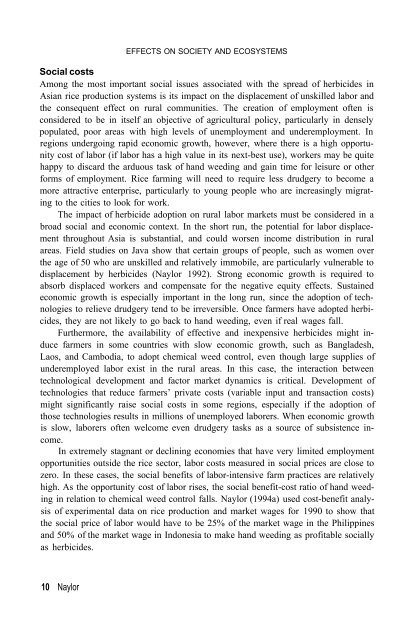HERBICIDES in Asian rice - IRRI books - International Rice ...
HERBICIDES in Asian rice - IRRI books - International Rice ...
HERBICIDES in Asian rice - IRRI books - International Rice ...
Create successful ePaper yourself
Turn your PDF publications into a flip-book with our unique Google optimized e-Paper software.
EFFECTS ON SOCIETY AND ECOSYSTEMS<br />
Social costs<br />
Among the most important social issues associated with the spread of herbicides <strong>in</strong><br />
<strong>Asian</strong> <strong>rice</strong> production systems is its impact on the displacement of unskilled labor and<br />
the consequent effect on rural communities. The creation of employment often is<br />
considered to be <strong>in</strong> itself an objective of agricultural policy, particularly <strong>in</strong> densely<br />
populated, poor areas with high levels of unemployment and underemployment. In<br />
regions undergo<strong>in</strong>g rapid economic growth, however, where there is a high opportunity<br />
cost of labor (if labor has a high value <strong>in</strong> its next-best use), workers may be quite<br />
happy to discard the arduous task of hand weed<strong>in</strong>g and ga<strong>in</strong> time for leisure or other<br />
forms of employment. <strong>Rice</strong> farm<strong>in</strong>g will need to require less drudgery to become a<br />
more attractive enterprise, particularly to young people who are <strong>in</strong>creas<strong>in</strong>gly migrat<strong>in</strong>g<br />
to the cities to look for work.<br />
The impact of herbicide adoption on rural labor markets must be considered <strong>in</strong> a<br />
broad social and economic context. In the short run, the potential for labor displacement<br />
throughout Asia is substantial, and could worsen <strong>in</strong>come distribution <strong>in</strong> rural<br />
areas. Field studies on Java show that certa<strong>in</strong> groups of people, such as women over<br />
the age of 50 who are unskilled and relatively immobile, are particularly vulnerable to<br />
displacement by herbicides (Naylor 1992). Strong economic growth is required to<br />
absorb displaced workers and compensate for the negative equity effects. Susta<strong>in</strong>ed<br />
economic growth is especially important <strong>in</strong> the long run, s<strong>in</strong>ce the adoption of technologies<br />
to relieve drudgery tend to be irreversible. Once farmers have adopted herbicides,<br />
they are not likely to go back to hand weed<strong>in</strong>g, even if real wages fall.<br />
Furthermore, the availability of effective and <strong>in</strong>expensive herbicides might <strong>in</strong>duce<br />
farmers <strong>in</strong> some countries with slow economic growth, such as Bangladesh,<br />
Laos, and Cambodia, to adopt chemical weed control, even though large supplies of<br />
underemployed labor exist <strong>in</strong> the rural areas. In this case, the <strong>in</strong>teraction between<br />
technological development and factor market dynamics is critical. Development of<br />
technologies that reduce farmers’ private costs (variable <strong>in</strong>put and transaction costs)<br />
might significantly raise social costs <strong>in</strong> some regions, especially if the adoption of<br />
those technologies results <strong>in</strong> millions of unemployed laborers. When economic growth<br />
is slow, laborers often welcome even drudgery tasks as a source of subsistence <strong>in</strong>come.<br />
In extremely stagnant or decl<strong>in</strong><strong>in</strong>g economies that have very limited employment<br />
opportunities outside the <strong>rice</strong> sector, labor costs measured <strong>in</strong> social p<strong>rice</strong>s are close to<br />
zero. In these cases, the social benefits of labor-<strong>in</strong>tensive farm practices are relatively<br />
high. As the opportunity cost of labor rises, the social benefit-cost ratio of hand weed<strong>in</strong>g<br />
<strong>in</strong> relation to chemical weed control falls. Naylor (1994a) used cost-benefit analysis<br />
of experimental data on <strong>rice</strong> production and market wages for 1990 to show that<br />
the social p<strong>rice</strong> of labor would have to be 25% of the market wage <strong>in</strong> the Philipp<strong>in</strong>es<br />
and 50% of the market wage <strong>in</strong> Indonesia to make hand weed<strong>in</strong>g as profitable socially<br />
as herbicides.<br />
10 Naylor

















